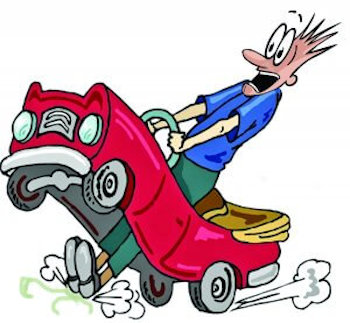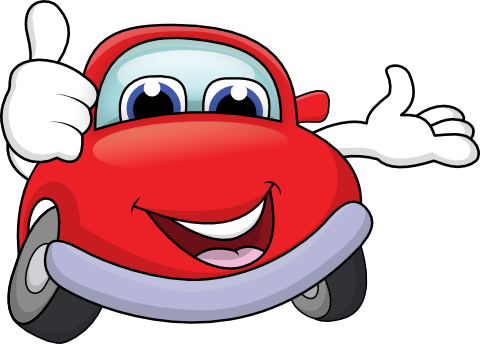


Mobile users:
For best results, view in Landscape mode.

Brake Fluid -
There are three common types of brake fluid:
DOT3, DOT4, and DOT5.
DOT3 is the most common and should also be the cheapest.
Unfortunately, DOT3 brake fluid also absorbs moisture the
fastest and has the lowest boiling point. DOT4 is also fairly
common but is a little more expensive.
DOT4 is designed to absorb moisture slower and has a
higher boiling point.
DOT5 is not as common and is the most expensive.
DOT5 does not absorb any moisture and has the highest
boiling point.
DOT3 and DOT4 are clear to amber in color, while DOT5
is purple.
Ask your mechanic to determine which type of fluid is required
for your car and how much will be required.
If you do choose to switch to a higher quality brake fluid,
it is strongly recommended that you perform a complete
brake system flush.
Brake Bleeding vs. Flushing -
The term "bleeding" means to remove the air locked in
the brake system; whereas, the term "flushing" means to
remove all of the old fluid and replacing it with new,
clean fluid.
Mechanics will usually bleed the brakes after a component has
been replaced and the hydraulic system had to be "opened".
To flush your vehicle's brake system, simply continue bleeding
each wheel until the fluid runs clean.
ABS brakes are potentially difficult to bleed because air can
be trapped in the high-pressure ABS pump and turn
into froth.
Signs of Brake Failure:
Squeaks and Noises -
When you hear strange noises when you depress the brake
pedal, the most common are squeaks and grinding.
Friction from the brake lining causes heat.
Constant grinding sound is never good. Under extreme conditions
this can damage the pads and/or lining, brake drums and rotors.
Pulling to one side or brake drag -
Worn or uneven brake linings or a damaged brake line can cause
your car to pull to one side.
Brakes that are out of adjustment or have contaminated fluid can
cause brakes to drag.
Low or Fading Brake Pedal -
Does the pedal sink to the floor board when you're stopped
at a light? Or feel "spongy"?
There may be a leak in the brake system, air in the brake
lines, or the need for a brake adjustment.
It could also be caused by low fluid, sticking calipers,
worn pads, or hydraulic system problems.
Brake Light -
Is the "brake" light on?
<<<Warning>>>
As soon as you notice any problem,
get it repaired immediately.
Delaying brake repairs is extremely
dangerous!
Inspecting Your Brakes:
Master Cylinder -
The master cylinder, contains a reservoir for brake fluid.
It is located on the firewall and should be checked periodically
to ensure the proper fluid level.
Brake Lines -
Attached to the master cylinder, steel brake tubing runs to all 4 wheels.
Brake lines should be inspected for rust, which can lead to leaks.
If the lines are damaged they should be replaced.
Brake Hoses -
Rubber brake hoses run from the brake lines to the brake
calipers and wheel cylinders.
Constant exposure to road grime, dirt, salt and other
elements can cause the rubber to become brittle and crack,
leading to brake failure.
Calipers and Wheel Cylinders -
Brakes are activated by brake fluid pressure from the master cylinder
pushing a piston located in the caliper or wheel cylinder against the
pad or shoe.
A leak can cause erratic braking or brake failure.
Shoes, Linings and Pads -
The pads and brake shoe linings should be checked
periodically for uneven or excess wear, cracking on the friction
surface, glazing, or saturation from brake fluid or grease.
If defects are found, replace the pads immediately.
Shoes
should be worn evenly and have no rivets protruding
to the friction surface.
Drums -
The drums should not have excessive grooves
or have a deep
"trough" dug into them where the shoes ride.
Wheel bearings should be inspected and lubricated periodically.
Worn wheel bearings, which can cause faulty steering as well as
erratic braking, should be replaced.
Rotors -
Rotors should be inspected completely around the surface
and on both sides for any grooves or obvious defects.
If defects are found, replace your rotors immediately.
Any rotor discoloration may be a sign of overheating.
Badly worn or overheated rotors can damage wheel
bearings and the complete wheel hub assembly.
These parts often cost as much or more
than the brakes themselves.
Parking Brake -
The parking brake should be adjusted
periodically.

While we attempt to insure these tips
and information is complete and
accurate, these tips are merely a
recommendation to help save you time,
money and to stay safe on the road.
Check with your mechanic for professional advice
or service before attempting to perform any work
you are not qualified to do.

